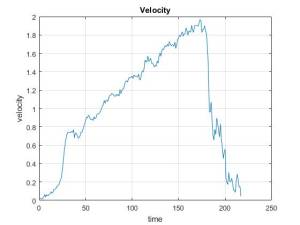Table of Contents
Optitrack Motion Capture System Getting Position & Velocity Data
Author: <Hyunhee Lee> Email: lee67@unlv.nevada.edu
Date: Last modified on <05/08/17>
Keywords: <Motion capture, Rigid Body, Export data, Position data, Velocity data>

This picture show the “Arena” software program interface for capturing the “dots” motion.
The blue 3D area is the capture volume which means dots are tracked only inside of that volume.
It provides the position and orientation data about dots especially rigid body.
This tutorial will explain about how to get position and velocity data.
Motivation and Audience
This is a tutorial about getting position & velocity data from Optitrack Motion Capture system. If you are not familiar to use “Arena” which is Optitrack Motion Capture system software, Please take look at up the “Optitrack Motion Capture System Setup Guide” http://daslhub.org/unlv/wiki/doku.php?id=optitrack_motion_capture_system_setup_guide
Once you know how to record the “dots” movement, you can get the position data through “Arena” software program. But, you need to use other tool(e.g. matlab or excel) for calculating velocity.
* Experience about “Arena” software.
* Know how to get velocity data from position data.
The rest of this tutorial is presented as follows:
Create Rigid Body
In order to get the position and orientation data through “Arena”, The Rigid body should be created for tracking the motion. There is one condition in order to create the rigid body. When you capture the motion, at least 3 dots should be used for motion inside of capture volume. Because when you try to create the Rigid body using “Wizards”, it requires you at least 3 dots in the captured video.
Step 1.
 See the menu on the top and click the “Wizards” and go to click “Rigid Body” and click “Next”.
See the menu on the top and click the “Wizards” and go to click “Rigid Body” and click “Next”.
Step 2.
 Click the bottom option and find out video that you recorded and open it.
Click the bottom option and find out video that you recorded and open it.
Step 3.
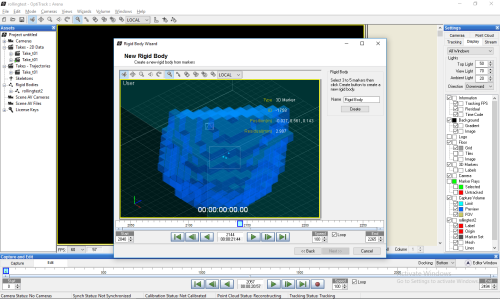 Drag or click between 3~5 dots that you want to create for rigid body.
Drag or click between 3~5 dots that you want to create for rigid body.
Step 4.
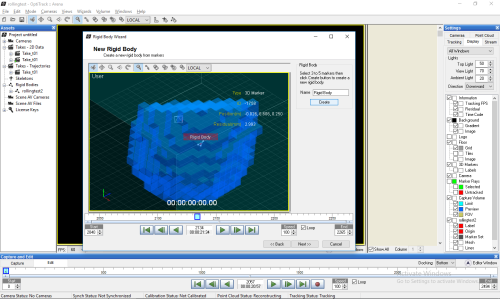 Gives name for rigid body and click the “Create” button on right hand side and click “Next”.
Gives name for rigid body and click the “Create” button on right hand side and click “Next”.
Step 5.
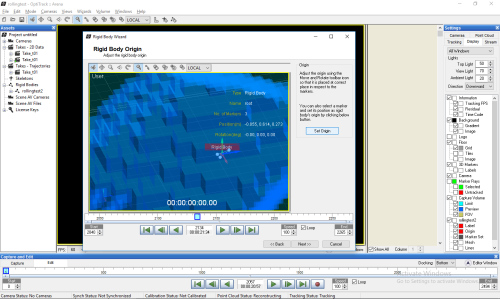 You need to set the “Origin” of rigid body.
Either way, you can choose one of the dots of rigid body or center of rigid body and click “Next”.
You need to set the “Origin” of rigid body.
Either way, you can choose one of the dots of rigid body or center of rigid body and click “Next”.
Step 6.
 If you want to attach the “3D polygon” in rigid body, you can choose one of the shape.
If you do not want to attach just leave it. And click “Next”.
If you want to attach the “3D polygon” in rigid body, you can choose one of the shape.
If you do not want to attach just leave it. And click “Next”.
Finish.
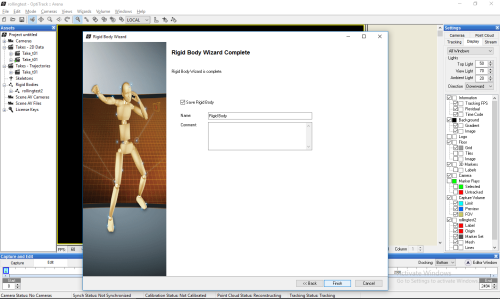 Click “Finish”
And check that there is file you named under the “Rigid Bodies” on the left hand side.
Click “Finish”
And check that there is file you named under the “Rigid Bodies” on the left hand side.
Trajectorize
Once you have made the rigid body, you can trajectorize it for export data.
 Right click the file under the “Take-2D data” and click “Trajectorize” button and check that there is file under the “Takes-trajectories” on the left hand side.
Right click the file under the “Take-2D data” and click “Trajectorize” button and check that there is file under the “Takes-trajectories” on the left hand side.
Position data
After trajectorize, you can click the origin of the rigid body and play video or dragging the time cursor on the bottom, you can see the position data on the right hand side corner of video. Also, you can make raw data sheet with it.
 It shows 3D(x,y,z) position data and orientation angle data.
It shows 3D(x,y,z) position data and orientation angle data.
Export data
If you want to get raw data, you can have data for position and orientation by export data.
 Right click the file under the “Takes-trajectories” and click “Export BVH” or “Export C3D” or “Export FBX” button whatever you prefer to export file.
Right click the file under the “Takes-trajectories” and click “Export BVH” or “Export C3D” or “Export FBX” button whatever you prefer to export file.
 This is the raw data BVH file that exported from “Arena” software.
You can change this file to “txt” or “excel” file for loading to other software tools.
This is the raw data BVH file that exported from “Arena” software.
You can change this file to “txt” or “excel” file for loading to other software tools.
Acquire velocity data
You can get velocity data by derivative position data. Using this equation, you can get velocity data of x,y,z. This is time dependent acceleration.
Using this equation, you can get velocity data of x,y,z. This is time dependent acceleration.
Once you get the x,y,z velocity data,
v = √((xi)^2) + ((yi)^2) + ((zi)^2)
exploit this equation to get velocity of rigid body.
This is the position profile by exported raw data using “matlab”

This is the velocity profile by exported raw data using “matlab”
